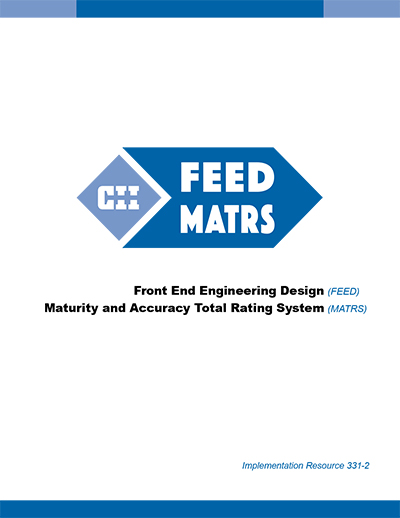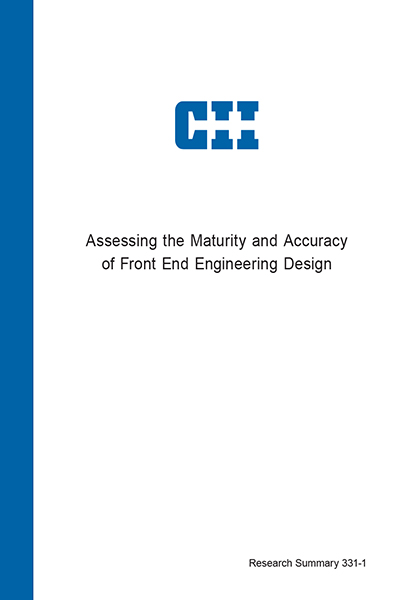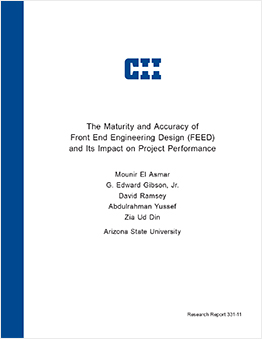
Front End Engineering Design (FEED) Maturity and Accuracy Total Rating System (MATRS)
CII Research Team 331 (RT-331), Assessing the Maturity and Accuracy of Front End Engineering Design (FEED) to Support Phase-gate Approvals, developed this resource to help stakeholders of large industrial projects to assess both the maturity and accuracy of FEED deliverables during the front end planning (FEP) process. In addition to producing this publication, the team created a macro-enabled Excel file that combines the maturity and accuracy tools into one spreadsheet. RT-331 named both this book and its accompanying software the Front End Engineering Design (FEED) Maturity and Accuracy Total Rating System (MATRS) tool, which it shortened to FEED MATRS (pronounced “FEED matters”).
With this publication, CII fills a critical gap in the FEP body of knowledge. This document and its accompanying tool help project teams evaluate FEED maturity and accuracy for large, complex industrial projects, whether they involve new construction, renovation and revamp, or both. The FEED MATRS tool is complementary to Implementation Resource (IR) 113-2, PDRI: Project Definition Rating Index – Industrial Projects, and IR320-2, Tools for Enhancing the Quality of Problematic Design Deliverables.
Project teams and owners expend substantial effort to develop scope definition during the front end planning (FEP) of large industrial projects. Many times, however, these projects have either immature or inaccurate front end engineering design (FEED). As an initial part of this research effort, RT-331 developed a standard defintion of FEED: “a component of the FEP process performed during detailed scope (Phase 3), consisting of the engineering documents, outputs, and deliverables for the chosen scope of work.” This implementation resource summarizes the motivations and efforts of RT-331 to develop an FEP tool to assess the maturity and accuracy of engineering design during FEED for large industrial projects, and then shows users how to deploy that tool.
RT-331 reviewed and adapted the Project Definition Rating Index (PDRI) for Industrial Projects and other past CII work to develop a set of 46 maturity elements and 27 accuracy factors that correlate with project performance. Forty-six of the 70 elements from the PDRI–Industrial were considered to be engineering elements, and therefore included in the maturity-assessment section of this publication. The accuracy factors were developed from past FEP literature and finalized in workshops.
The FEED MATRS tool assesses the maturity of FEED deliverables in ways that are similar to the PDRI, but FEED MATRS only evaluates the PDRI elements that are associated with the engineering design effort during FEP activities – specifically, during detailed scope (Phase 3) leading up to Phase Gate 3. The maturity tool can be used in a variety of ways; for example, at the beginning of FEED to set expectations, or at the end of FEED as an auditing tool. It may be used on its own, with a facilitator, or in conjunction with the PDRI–Industrial to output a maturity score at Phase Gate 3.
In addition to delivering a maturity assessment, FEED MATRS can also determine the accuracy of FEED deliverables by evaluating the enabling or external factors associated with FEED processes that have the potential to affect project performance. These factors include the experience of the individuals developing FEED deliverables and the resources available to develop FEED. In all, RT-331 identified 27 accuracy factors from literature, and then FEED industry professionals vetted these factors through a series of data collection workshops.
The development effort included four industry-sponsored workshops where the maturity elements and accuracy factors were evaluated by 48 professionals with an average of 20 years of project management and engineering experience. These engineering professionals also prioritized and rank-ordered the accuracy factors to develop a corresponding weighted score sheet through statistical analysis. The RT-331 tools were tested on 33 completed and 11 in-progress projects. These analyses showed that industrial projects whose FEED was more mature and accurate outperformed those with less FEED maturity and accuracy in terms of four performance areas: cost, changes, financial performance, and customer satisfaction. Specifically, they found that projects with high maturity and high accuracy outperformed projects with low maturity and low accuracy by 24 percent regarding cost changes, and 12 percent in terms of change orders.
The accuracy and maturity assessment tools are designed to be used in parallel to output both maturity and accuracy scores. These scores can be plotted on a four-quadrant matrix that is correlated with project performance. This document gives the user the tools to achieve high maturity and high accuracy on large industrial projects.
While the FEED MATRS tool correlates FEED maturity and accuracy scores with project performance, another valuable output from the process is the insights that can be gleaned from the remarks, lessons learned, and coordinating tasks identified during the assessment session. By using these additional findings, executive leadership can better assess where and how to commit limited resources to enhance project performance.



